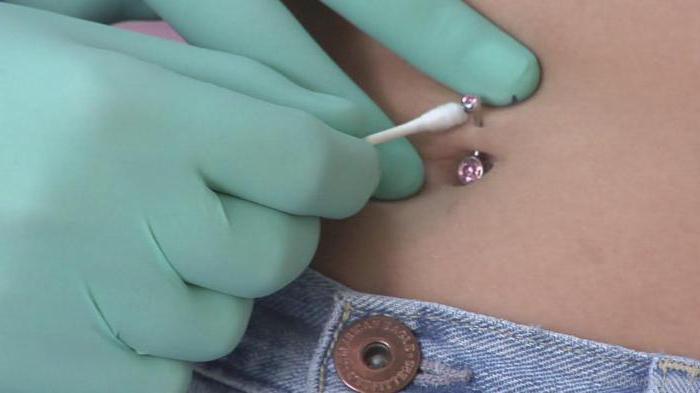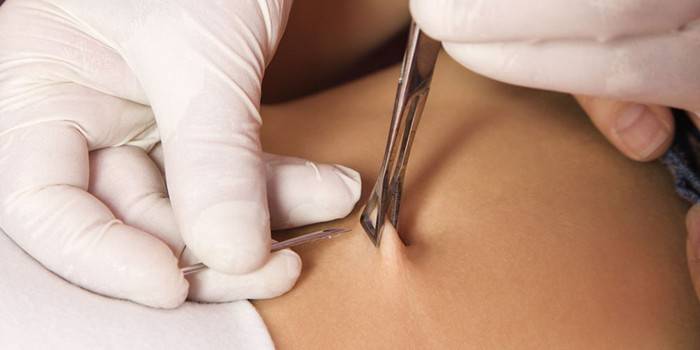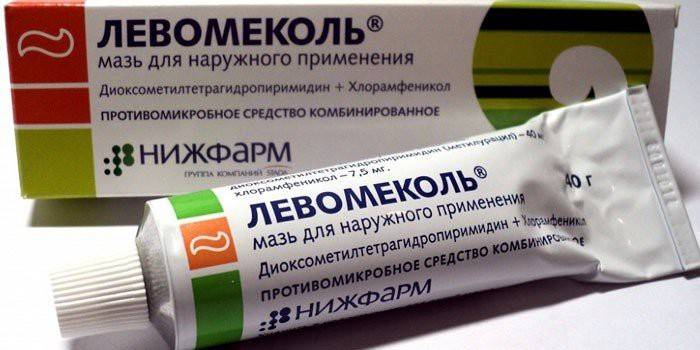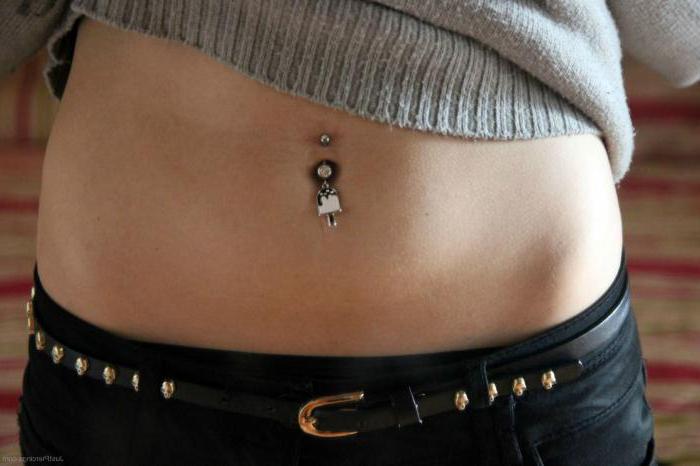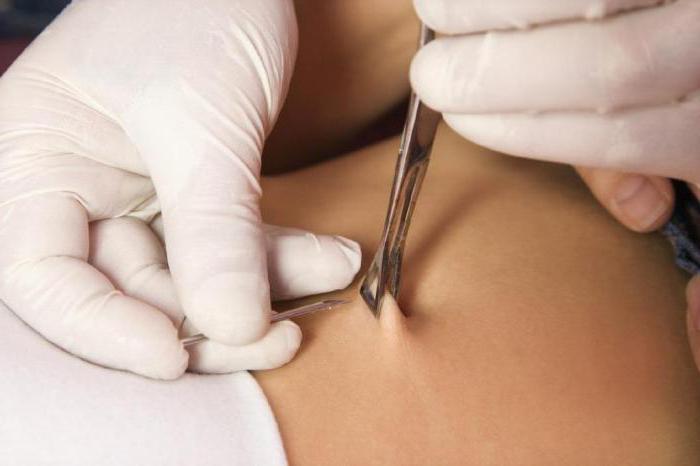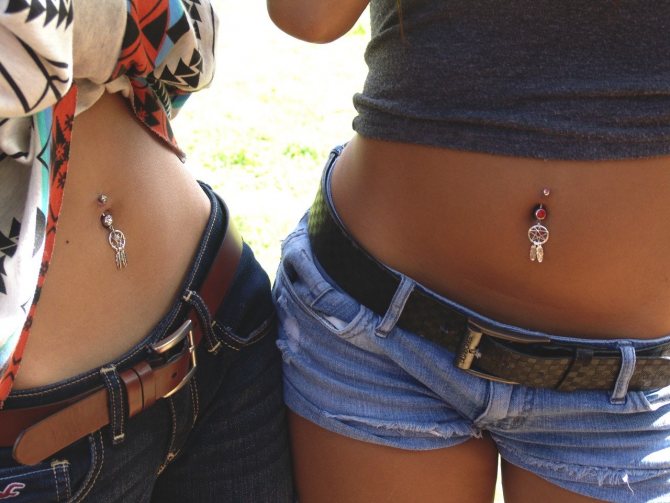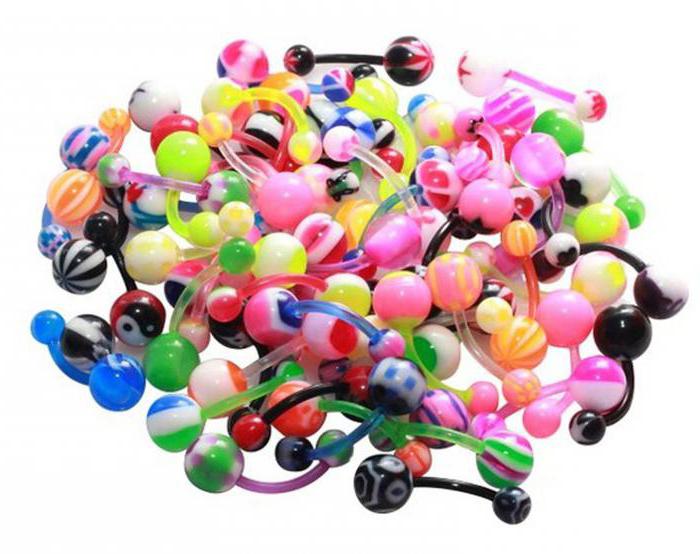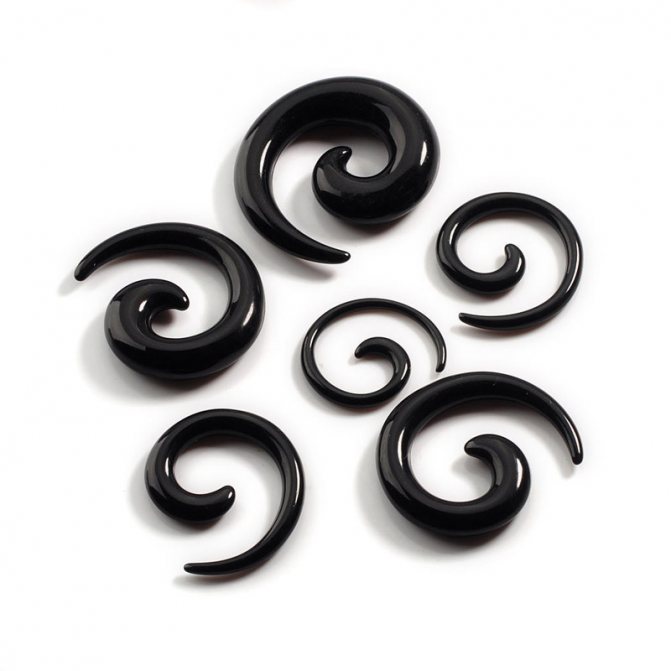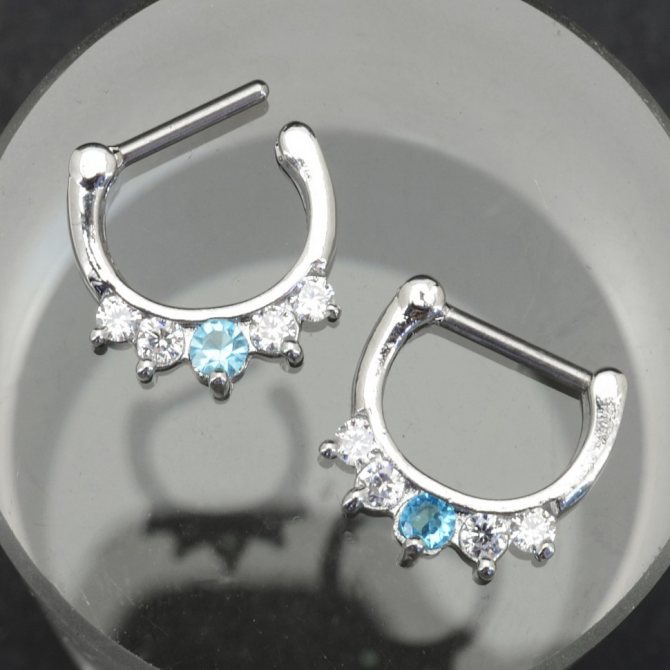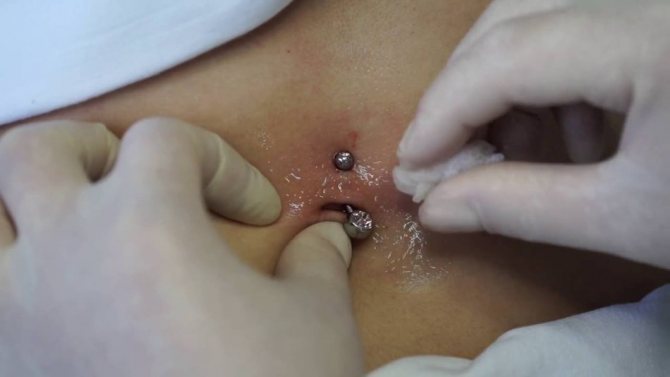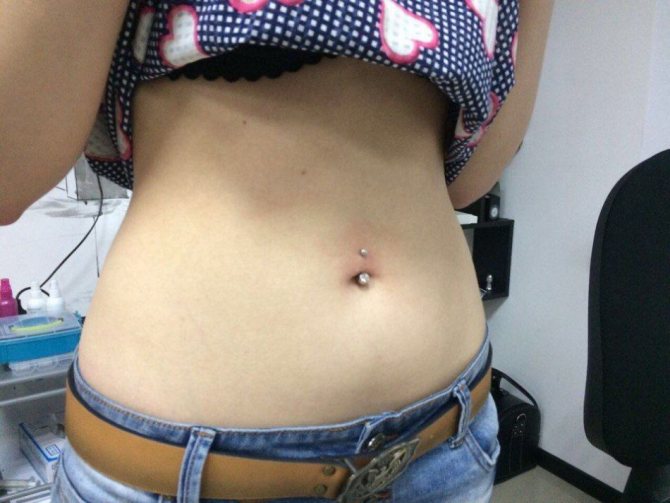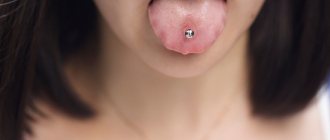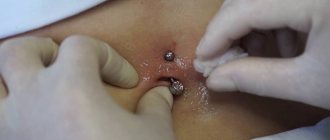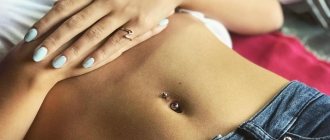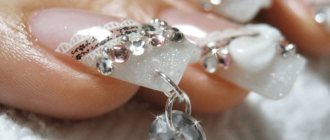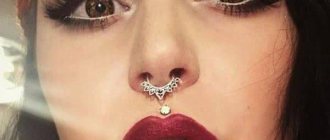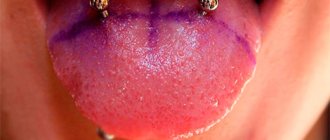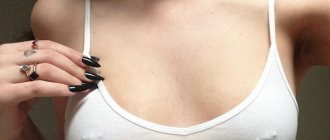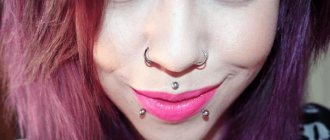A belly button piercing is the most common of the needle-catheter piercings.
The tools for belly button piercings are: Oval ended clip, #16 or #14 piercing catheter needle.
Belly button jewelry: banana, ring.
Processing before belly button piercing: We treat the puncture site with a special antiseptic tissue or ethyl alcohol 95%, we dip the banana earring with the removed balloon into the antiseptic solution for 15-20 minutes (alcohol 95%, disinfectant solutions).
How to make a piercing
There are two options on how to make piercings: with a pistol and a needle. The process of piercing with a pistol is fundamentally different from piercing with a needle. At the same time, professional craftsmen believe that it is safer and faster to work with a steel needle.
The gun Provides a quick and silent piercing. In most cases, you do not even need to use anesthesia during the procedure. Does piercing with a gun hurt? Rather, it is unpleasant, just like ear or eyebrow piercing.
But, you need to keep in mind the possibility of getting an infection. Pistols have a complicated design, which makes them quite difficult to clean. During the puncture, some of the cells get under the holder and the next time you puncture (even if the needle is replaced), they can go into the bloodstream of the next patient.
Needles are always used disposable, which minimizes the chance of introducing an infection or virus. But this process is more dangerous. While the gun has a fixed force and puncture length, the needle puncture is controlled solely by a specialist. For a successful session here, the experience of the master plays a major role. In addition, this method is often more painful. Exactly the same method is used to pierce the nose, lip or tongue.
How the piercing procedure takes place:
- The patient exposes the abdomen for the piercing. The master treats the belly button with special antibacterial solutions. This can be alcohol, Chlorhexidine, etc;
- A jewel is inserted into the gun (if used). If the master works with a needle, it is treated with an alcohol solution after being removed from the bag;
- The puncture point is marked. The evenness is determined visually, at this point it is very important not to move. After the puncture is made. Most often, the specialist first inserts a banana ornament, and after healing, a butterfly, pendant or other earrings for belly button piercing can be used;
- The hole with the ornament is treated with an antibacterial solution. Or, a piece of jewelry is inserted into the hole, after which it is lubricated with ointments and solutions for safety.
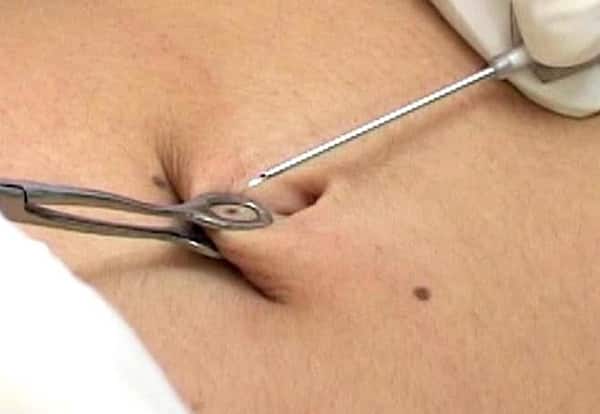
Belly button piercing.
Theoretically, it is possible to perform the session at home, but it is very dangerous. If you pierce without previous experience, you can hurt the skin of the abdomen above the belly button or get an infection.
Video: how the belly button piercing is visually performed
Pros and cons of the procedure
Among the advantages should be noted:
- attractive appearance;
- The attention of the opposite sex;
- The opportunity to once again draw the attention of others to his beautiful figure.
What are the disadvantages:
- the procedure is painful and traumatic;
- piercing heals for a long time;


All about belly button piercing
- Boils and abscesses can occur;
- The puncture site is not safe because you can get into a biologically active area.
You're not intimidated by the disadvantages of the belly button piercing method. Then next we talk more about the technical side of the issue, in order to minimize the risks.
How long does it take to heal and what to treat it with
Reviews claim that the healing of belly button piercings is strictly individual. The average time is from 1 week to 2 weeks, in men this period can be reduced to one week. Interestingly, for fat girls, the process slows down a little due to the greater amount of damaged tissue under the piercing.
The wound should be treated as needed. In the first few days, you need to flush the puncture hole 3 or more times. This is to prevent rotting. Chlorhexidine is used for rinsing, which heals both large wounds and microcracks. It is not necessary to drip alcohol on an open wound - it severely dries the skin.
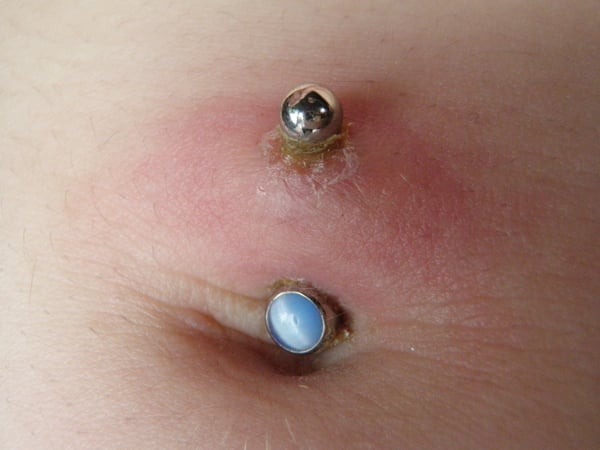

Healing the belly button
Lubricate the earring with Spasatel, Celitel, Levomekol or any other antiseptic ointment. Apply a little product to the earring itself, and then move it a few times so that the ointment spreads inside the wound. Also apply a pea of the ointment under and over the earring.
Is it worth piercing your belly button?
Belly button piercing is done mostly by young girls who decided to decorate their bodies. In the procedure itself there is nothing terrible. But you should not do belly button piercing, if the body began or developed an inflammatory process. Cosmetologists do not recommend doing it in case of exacerbation of chronic diseases or even with a simple cold. Then the place of the piercing will heal much longer and more likely to get an infection in it.
Also, piercings should not be done by those who are actively engaged in sports. The navel area is considered one of the dirtiest in the body, there accumulates a lot of sweat. All this can be fraught with various complications and causes irritation. If you like to wear tight clothes, the belly button after the piercing will take a very long time to heal. Anything, even the most natural fabric, rubs against the body and creates irritation.
Cosmetologists point out that belly button piercing is not recommended for people who are overweight. It is also associated with the formation of bacteria, which appear in the folds. Girls with a convex belly button also should not do it. They simply do not have a crease, which is pierced in the process. The decoration will not look aesthetically pleasing, and that is its main task.
If you realized that you can not do without the earring in the belly button, and you are sure that you want to suffer a little to attract the attention of all the beautiful piercings, find in your schedule for 15 minutes twice a day to look after the place of the piercing. This regimen should be followed for about four months. You will also need to periodically remove the earring and soak it in a saline solution for 10 minutes at a time.
Choosing the material for the jewelry
The right choice of earring material not only determines your look, but also the success of the entire procedure. The most popular are precious metals: it is silver or gold belly button piercings. If you want to insert your own earring right away, the master should be warned about it before the session, especially if he works with a gun.
Types of materials for belly button piercings:
- Steel. In fact, there is no concept of "surgical" steel. It is a regular steel alloy with nickel and chromium added to it. Thanks to the alloying, it does not rust and promotes healing (due to the perfectly smooth surface of the jewelry);
- Bioplastic or medical plastic.. It is used when all other earrings cause redness and inflammation. It is rarely inserted right after the puncture, but more often in the 3rd week of healing;
- Titanium. A stainless metal that is often used in medical practice. It is believed to have anti-inflammatory and antibacterial properties;
- White and yellow honey gold. Naturally, the higher the proof, the better. But at the same time, some girls may be allergic to beautiful gold earrings for belly button piercing. This metal promotes accelerated tissue regeneration and protection against infection.
- Silver - A more affordable analogue.
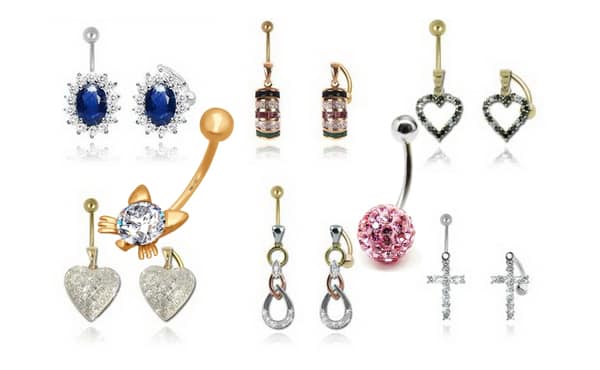

Jewelry for piercing
Buy jewelry (with a diamond or Swarovski stones) for belly button piercing can be found in specialized stores. Some salons also provide the opportunity to choose an earring directly before the session.
Finding a salon
During the choice we will find professional salons and non-professional and all of them should be checked for suitability, at least according to the reviews and the variety of jewelry that they provide.
How to determine the qualifications of the master
The more qualified the specialist, the better. This is easy to do. A salon or a master with high qualifications must have the following:
- Domestic or international piercer certificate can only be issued by an already existing master piercer making his career in this field
- An extensive variety of piercings makes you constantly improve and raise your level of knowledge and get new qualification documents
- Always evaluate the appearance of the salon and the master. If you see that the salon is not cleaned, immediately turn around and leave.
- Find out how many years the salon or piercer has been working, and what kind of feedback people have about it.
What piercing
An experienced and skilled craftsman prefers a hollow needle to a gun. Do not choose a salon that only pierce with a pistol, because the wound will be torn and heal longer, and if it heals longer, there will be more discomfort.
Choice of jewelry
A safe salon uses high quality jewelry that is usually made of stainless steel, titanium, pure gold or high-grade gold, and some even contain strontium.
The good jewelry is distinguished from the bad by the fact that the former is made strictly according to the state
Personal recommendation to you. Try to choose ASTM F-136 alloy titanium as the first piece of jewelry for healing, as it stands out because of its high biocompatibility.
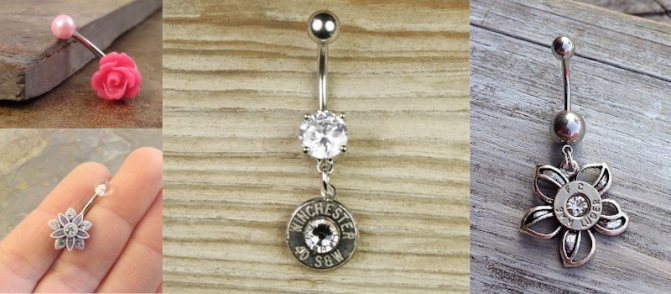

How to take care of a belly button piercing
To avoid rejection of the jewelry, you should regularly wash the wound and lubricate it with ointments. It is also recommended for the first time to limit the contact with the earring and clothing. For this purpose, the navel is covered with a plaster for the time of leaving the house.
Tips for caring for the belly button at home:
- If the belly button is very festering - rinse it with salt water for a few days. Sea salt is ideal;
- It is most convenient to wash the wound without the earring, but for the first week it is strictly forbidden to remove the piercing. Therefore, you can arm yourself with a syringe and with a pressure of Chlorhexidine wash out of the hole treasures and pus;
- Proper care involves the constant application of regenerating compositions. After lubricating the belly button, be sure to twist the earring several times - so the ointment spreads better over the wound;
- Quickly relieve inflammation and suppuration will help hydrogen peroxide and Levomecol. It is necessary to wash the wound several times with peroxide, and then spread the ointment well. It is allowed to use hydrogen no more than once a day. With severe decay, it is better to replace it with sea salt, as mentioned above;
- During the healing process, it is necessary to limit bathing in open bodies of water, sun bathing and walking on dusty terrain with an open navel.
Memo on belly button piercing care|Memo
4 messages
A piercing is a wound. In order for it to heal, it is necessary: not to interfere with the body's own treatment of the wound and keep it clean. For this we need an antiseptic solution of Miramistin (not an ointment!) or Chlorhexedine. Only one solution should be used for treatment, Miramistin is preferable. During the first 3-4 days it is recommended to wet a cotton pad with a gauze napkin with one of these solutions and make compresses for 10-15 minutes 3-5 times a day. Then the whole period of healing (6-9 months or longer) you need to irrigate the piercing 2-3 times a day. It is not necessary to move the jewelry "to get the solution inside", it will get in anyway. IMPORTANT: If there is a crust near the puncture, you need to soak it during treatment with a compress and gently remove it with a cotton swab. Do not rip off the crust! During the treatment of the piercing you must not allow contact of the wound and surrounding skin with any non-sterile surfaces (dirty hands, "spouts" of bottles with solutions, etc.)
On the day of the piercing procedure, you should refrain from coming into contact with tap water. The next day you should stop wearing the plaster. The first 2-3 days after the procedure it is not recommended to lift heavy objects (more than 3 kg), as well as the use of alcohol, drugs and any blood thinning medications (eg, Aspirin, Paracetamol). In two weeks of healing it is recommended to take Vitamin "C", multivitamins to speed up the healing process and help the immune system.
DO NOT before FIRST* healing and during inflammation of the piercing: - Take a bath, go to a sauna, bathhouse, swimming pool, bathe in open water or any other way to steam and soak the channel of a fresh piercing - Visit a solarium or sunbathe - Wear dirty, tight, woolen or synthetic clothing - Exercise in sports
DO NOT touch the piercing with hands that you have not just washed - Take out, twist, move, lift, pull up the jewelry or press on the piercing area - Change the jewelry by yourself or unnecessarily - Exert pressure on your abs - Wear soiled, tight, woolen clothing, high-waisted pants and jeans
*FIRST healing is when there is no discharge, redness, discomfort in the puncture area. Comes in at least 3 months and depends on many factors (for example, the state of immunity, the quality of jewelry and other). *FULL healing is the moment when the epithelium inside is formed. It occurs in at least 5, but more often 6-9 months.
It is STRONGLY FORBIDDEN to use any products for piercing that are not listed in this leaflet. This includes Peroxide and Levomecol.
What is NORMAL? In the first week, the puncture may bleed, itch, hurt, be swollen and red. In the first month there may still be some redness near the puncture. During the entire healing period, an odorless white-yellow fluid may be secreted from the puncture, which dries with a yellow crust. This is a normal discharge. The distance between the canal outlets may be reduced by 1-2 mm. If the ornament turned out to be large, you can change the ornament at the master. Or on your own, in case the piercing has already healed.
What is NOT NORMAL? - Severe swelling - Pain, itching, and rash after handling the piercing - Jewelry pressing and digging into the skin - Severe redness - Rash in the area of the piercing - It is impossible to touch the area of the piercing because of pain - Red or black broken lines spreading from the piercing - Temperature above 38 degrees - Loss of orientation, hallucinations - Thick, almost non-drying discharge with a terrible smell, yellow, green or blue
Possible consequences
Is belly button piercing harmful or not - this is a very topical issue, because until now doctors, piercing masters and esoterics argue about it. This process is very dangerous because of the high probability of contracting an infection, and can also begin rejection of the material with improper care or the selection of jewelry.
Possible complications:
- The most unfortunate piercing is when it fouls up and the earring "sinks" into the skin of the navel. The process is very unpleasant. Here you need an urgent consultation with a doctor and further treatment, otherwise the belly button can just tear;
- If you pierce the belly button in winter, it will be rubbed by clothing and inflammation. And if it is summer, you will not be able to swim or sunbathe. At the same time, it is also impossible to remove the earring because of the likelihood of bacteria and tissue healing;
- Often a dark spot will form around the piercing. This is the dead epidermis. Depending on your skin type, it will eventually become less noticeable or simply peel off;
- Some women on forums write that their belly button piercings do not heal even after 6 months of care. This suggests that the body rejects the jewelry, and the best way out is simply to remove it. A small scar will remain at the site of the piercing.
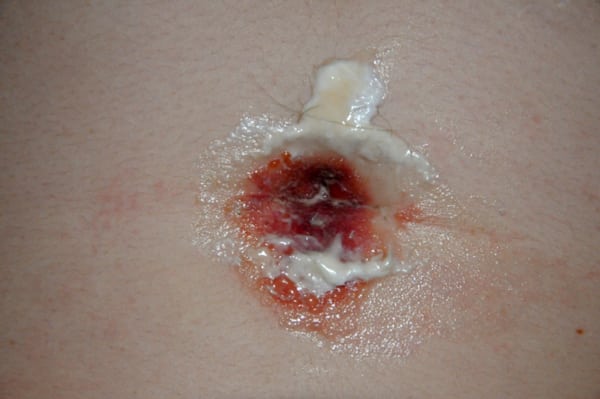

Photo - Consequences
What is not allowed after a belly button piercing - rules
The navel is considered to be a place quite difficult to pierce, and therefore you should know and observe a few important "no", in order for the wound to heal without complications:
- DO NOT use inexpensive jewelry of dubious quality for the belly button;
- DO NOT drink alcohol before piercing the navel;
- DO NOT pierce a mole or age spot;
- DO NOT pierce or change jewelry until the wound is completely healed;
- DO NOT bathe in open pools or bodies of water;
- DO NOT steam the wound in hot water.
Piercing during pregnancy
Of course, if you are already in a pregnant pregnancy, then piercing the navel is extremely undesirable. It can cause stress to the body. But after years of wearing an earring and subsequent pregnancy - what to do with the piercing?
If the size of the earring (and the belly) allows it, then it is quite possible to leave it. It does not harm the baby or the mother in any way, and besides, it is an exact guarantee that the hole will not heal. If the tummy is quite large, and the skin is strongly stretched, it is better to remove the earring. Otherwise, it can tear the belly button and leave an ugly scar. After pregnancy, you can re-pierce the piercing.
This is not a critical contraindication, although beauty salons are reluctant to work with such patients - there is a great risk of infection or further inflammation and rejection.
The price of belly button piercings as pictured in different cities and by different artists varies significantly.
Belly button earrings. What are they?
A few popular shapes, of which you will surely choose something close to yourself:
- Banana
Slightly rounded bar with decorations, rhinestones on both sides. The shape is reminiscent of an overseas fruit. Additionally it is possible to hang chains, pendants.
- Spiral
An object with one or more whorls, similar to a piece from a spring with decorations.
- Ring
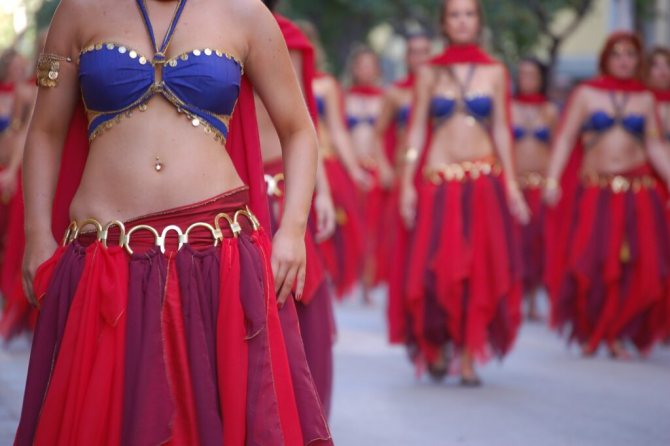

Image by Alejandro Vidal from Pixabay
Round. Everything is easy and straightforward. You can attach extra pretty pieces.
- Circular
Crescent or horseshoe shape with twisted edges. Clips are worn on both sides.
- Clicker
Reminiscent of an earring with an English lock: a half-ring with a bar that closes with a clicker. Originally used as a nasal septum piercing.
